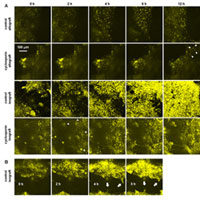 |
Medical Usefulness of the Sponge
Marine animal offers insights into the basics of immunity
January 16, 2008
 |
|
 |
Resources:
Citation: Sabella, C., E. Faszewski, L. Himic, K.M. Colpitts, J. Kaltenbach, M.M. Burger, and X. Fernàndez-Busquets. 2007. Cyclosporin A Suspends Transplantation in the Marine Sponge Microciona prolifera. J. Immunol. 179: 5927-35.
August 2005 report
Image:
Click on thumbnail for larger image

Caption: In vivo fluorescence confocal microscopy study of the effect of Cyclosporin A (CsA) on M. prolifera grafts. A, Allogeneic or isogeneic grafts were prepared and placed in a Petri dish containing either seawater or seawater containing 2.5 g CsA/ml, and examined with the confocal microscope for 12 h. Each frame corresponds to the projection of all the confocal sections collected for the chosen time points. Arrowheads indicate individual cells. B, Control isograft where the apposed tissues do not make contact. Note the incipient cell bridges (arrows) that start growing into the gap.
|
 |
 |
MBL summer investigator Xavier Fernàndez-Busquets
|
|
MBL, WOODS HOLE, MA — Sponges are the simplest of all animals, lacking nerves, muscles, and organs. But as the oldest extant animals on Earth, they’ve obviously got what it takes to survive.
One striking ability of sponges, reports a team led by MBL (Marine Biological Laboratory) summer investigator Xavier Fernàndez-Busquets, is their tissues recognize “self” or “non-self” with a specificity that rivals the human immune system.
“Humans have a more developed immune response than sponges, but it is pretty amazing to find that sponges use many similar mechanisms that we do (in tissue rejection),” says Ellen Faszewski, an associate professor at Wheelock College who works with Fernàndez-Busquets at the MBL during the summer. Fernàndez-Busquets is a researcher at the Institute for Bioengineering of Catalonia, Spain.
The team uses grafting techniques to study tissue acceptance and rejection in the red beard sponge (Microciona prolifera), which is local to the Atlantic coast of North America, including Cape Cod. Their research can illuminate not only the medical problem of tissue rejection in transplant patients, but the evolutionary origins of immunity.
Five years ago, Fernàndez-Busquets and colleagues reported that when tissues from the same or different sponge individuals are brought into contact, they either fuse or reject through cellular events similar to those observed in human grafts. When the team grafted tissues from genetically different sponges, a contact zone formed between them where “gray cells” and other cells accumulated. This triggered programmed cell death at the graft interface, a phenomenon that has also been associated with human tissue rejection. And it opened up the question: Are the gray cells the sponges’ immune cells, similar in function to human T-cells?
The team’s most recent work, published in the Journal of Immunology, supports this idea. Here they found that a commonly used immunosuppressor in human transplantation, cyclosporin A, arrests the migration of gray cells towards graft contact zones and effectively blocks tissue rejection in marine sponges.
“This indicates that the cellular mechanisms for regulating self- and non-self recognition in vertebrates might have appeared at the very start of metazoan evolution,” says Fernàndez-Busquets. “It is likely that recognition of self was a prerequisite for maintaining individual genomes separate, which in turn was a must for the evolution of multicellular animals.”
A search for the molecules that mediate self/non-self recognition in sponges is next on the agenda for Fernandez-Busquets and Faszewski, with part of the work to be carried out at the MBL this summer. And they see the potential for sponge studies to contribute to another medically significant area. In the future, they plan to investigate the mechanisms mediating stem-cell generation is sponges, as an approach to better understanding stem cells in humans.
The MBL is a leading international, independent, nonprofit institution dedicated to discovery and to improving the human condition through creative research and education in the biological, biomedical and environmental sciences. Founded in 1888 as the Marine Biological Laboratory, the MBL is the oldest private marine laboratory in the Western Hemisphere. For more information, visit www.MBL.edu
|